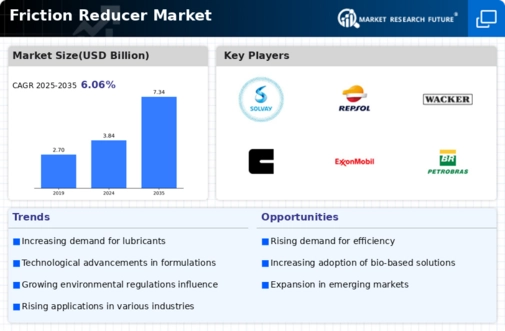Market Growth Projections
The Global Friction Reducer Market Industry is poised for substantial growth, with projections indicating a market value of 3.84 USD Billion in 2024 and an anticipated increase to 7.34 USD Billion by 2035. This growth trajectory reflects a compound annual growth rate (CAGR) of 6.07% from 2025 to 2035. The expanding applications of friction reducers across various industries, coupled with technological advancements and increasing environmental regulations, contribute to this positive outlook. As companies prioritize efficiency and sustainability, the friction reducer market is likely to evolve, presenting opportunities for innovation and investment.
Growing Industrial Applications
The Global Friction Reducer Market Industry benefits from the expanding industrial applications of friction reducers across sectors such as manufacturing, construction, and mining. These sectors require efficient lubrication solutions to minimize wear and tear on machinery, thereby enhancing productivity and reducing downtime. The increasing focus on operational efficiency and cost reduction drives the adoption of friction reducers in these industries. As companies strive to maintain competitive advantages, the demand for high-performance lubricants is likely to rise. This trend indicates a robust growth trajectory for the market, as industries recognize the value of investing in advanced friction-reducing technologies.
Rising Demand in Automotive Sector
The Global Friction Reducer Market Industry experiences a notable surge in demand driven by the automotive sector. As vehicle manufacturers increasingly focus on enhancing fuel efficiency and reducing emissions, friction reducers play a pivotal role in achieving these objectives. In 2024, the market is projected to reach 3.84 USD Billion, reflecting the industry's commitment to innovation and sustainability. The integration of advanced friction-reducing technologies in engine oils and lubricants is expected to contribute to this growth. Furthermore, the automotive industry's transition towards electric vehicles may further bolster the demand for specialized friction reducers, indicating a dynamic shift in market dynamics.
Increased Focus on Energy Efficiency
The Global Friction Reducer Market Industry is witnessing a heightened focus on energy efficiency across various sectors. As industries strive to reduce energy consumption and operational costs, the adoption of friction reducers becomes increasingly vital. These products enhance the performance of machinery by minimizing friction, leading to lower energy requirements. The push for energy-efficient solutions aligns with global sustainability goals, prompting industries to invest in advanced lubrication technologies. This trend is likely to drive market growth, as companies recognize the long-term benefits of incorporating friction reducers into their operations.
Technological Advancements in Lubrication
Technological advancements in lubrication systems significantly influence the Global Friction Reducer Market Industry. Innovations such as synthetic lubricants and nanotechnology-based friction reducers enhance performance and efficiency across various applications. These advancements not only improve the longevity of machinery but also reduce maintenance costs, appealing to industries seeking operational efficiency. As a result, the market is anticipated to grow at a CAGR of 6.07% from 2025 to 2035, reaching an estimated 7.34 USD Billion by 2035. The continuous evolution of lubrication technology suggests a promising future for friction reducers, as industries increasingly adopt these cutting-edge solutions to optimize performance.
Environmental Regulations and Sustainability
The Global Friction Reducer Market Industry is significantly impacted by stringent environmental regulations aimed at reducing emissions and promoting sustainability. Governments worldwide are implementing policies that encourage the use of eco-friendly lubricants and friction reducers. This regulatory landscape compels manufacturers to innovate and develop products that align with environmental standards. As industries shift towards greener practices, the demand for biodegradable and non-toxic friction reducers is expected to rise. This trend not only supports environmental goals but also presents opportunities for companies to differentiate themselves in a competitive market, fostering growth in the friction reducer sector.













